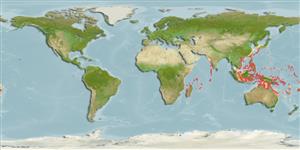Environment: milieu / climate zone / نطاق العمق / distribution range
البيئة
بحري مرتبطة بالشعاب; نطاق العمق 2 - 40 m (Ref. 90102). Subtropical
Indo-West Pacific: Maldive Islands to Micronesia and Fiji, north to Ryukyu Islands.
الحجم / وزن / العمر
النضج: Lm ? range ? - ? cm
Max length : 18.0 cm SL ذكر/ مختلط الجنس; (Ref. 559)
الأشواك الظهرية (المجموع) : 3; الأشعة الظهرية الناعمة (المجموع) : 43 - 45; شوكة شرجية: 1; أشعه شرجية لينه: 39 - 42. Identified by the long filaments on the dorsal fin of the male (Ref. 48636). Body scaleless above and below lateral line on anterior half (Ref 12934).
Body shape (shape guide): elongated.
Found in coastal reef slopes and deep outer reef lagoons in current channels. Usually in large groups with several large males (Ref. 48636). Inhabits sand-rubble bottoms (Ref. 90102). Found hovering above sandy slopes. Usually forms a harem of one male-phase fish and about a dozen female-phase fish (Ref. 37240). Normally buried when no current is running (Ref. 48636).
Life cycle and mating behavior
النضج | التكاثر | وضع البيض | بيض | الخصوبة | Larvae
Shimada, K. and T. Yoshino, 1984. A new trichonotid fish from the Yaeyama Islands, Okinawa Prefecture, Japan. Jap. J. Ichthyol. 31(1):15-22. (Ref. 37240)
IUCN Red List Status (Ref. 130435: Version 2025-1)
استخدامات بشرية
أدوات
تقارير خاصة
Download XML
مصادر علي الأنترنت
Estimates based on models
Preferred temperature (مرجع
123201): 24.6 - 28.8, mean 27.4 °C (based on 184 cells).
Phylogenetic diversity index (مرجع
82804): PD
50 = 0.5020 [Uniqueness, from 0.5 = low to 2.0 = high].
Bayesian length-weight: a=0.00389 (0.00180 - 0.00842), b=3.12 (2.94 - 3.30), in cm total length, based on all LWR estimates for this body shape (Ref.
93245).
مستوى غذائي (مرجع
69278): 3.5 ±0.5 se; based on size and trophs of closest relatives
Fishing Vulnerability (Ref.
59153): Low vulnerability (12 of 100).
🛈
